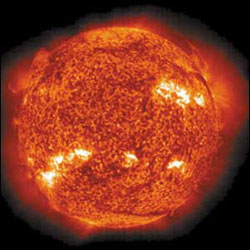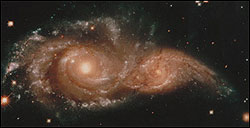The search for life: Astrobiology
By Monica Grady
Life beyond the Solar System
Our voyage through the solar system, in search of conditions in which life could originate, has encountered an enormous diversity of habitats--from the dry soils of Mars to the sulphurous geysers of Io and the ocean of Europa. Several space missions are planned for the coming decade that may shed more light on the issues highlighted by this course. Until then we can only speculate on the presence, or otherwise, of micro-organisms on bodies other than Earth, within our close neighbourhood. If we are going to speculate, then we need not confine ourselves to the solar system--the concept of a Habitable Zone, as discussed before, could extend to other areas in the universe. This session takes a look at other stars, in our galaxy and beyond, whose associated planets might be home to living organisms.
Stars

The Sun, as captured by the SOHO spacecraft. © ESA / NASA
Only a few types of stars are likely to support planetary systems. For a planetary system to exist, the presence of dust, or at least some type of solid material, is necessary. Without several generations of stellar cycling to produce these elements, no planets could form. Our sun has various characteristics that are essential for the existence of planets:
Age: At 4.56 billion years old, the sun is young enough to have high amounts of elements other than hydrogen and helium. The oldest stars to not contain enough of the other elements to allow for the existence of planets.
Stability: The sun has been stable over an extended period, allowing time for life not just to arise, but to evolve into the vast biodiversity that is seen on the Earth today. Unstable stars, such as rapidly rotating pulsars, that are susceptible to sudden outbursts of radiation, explosion or extremely rapid spin are much less likely to provided long stable periods in which life could evolve.
Size: Size is important. Stars much bigger than the sun tend to have a much shorter lifetime--the sun's total lifetime will be 10 billion years whilst a very large star might only exist for 1 or 2 billion years. This would not leave a long enough stable period for life to evolve. Additionally, massive stars emit much more ultraviolet radiation and this can lead to the stripping of the atmosphere followed by the destruction of organic molecules on the planet's surface. Massive stars are therefore unlikely hosts for life-bearing planetary systems. Stars that are smaller than the sun are cooler and emit less heat. So for a planet to be within the Habitable Zone of such a star, it would have to orbit close to the star, resulting in problems from higher gravitational attraction.
So although there are many billions of stars in our galaxy, many of them are types (too old, too big, too small, too energetic) that are unlikely to support planetary systems for sufficient lengths of time for lifeforms to arise or evolve.
Galaxies

Two galaxies colliding: NGC 2207 on the left, IC 2163 on the right. © NASA/ Space Telescope Science Institute.
Galaxies are vast accumulations of stars and they evolve and change with time. They collide and merge with each other, cannibalising dust and gas from their companions in the process. The observation programme at the Anglo-Australian Observatory has so far located about one hundred thousand galaxies that are distributed through the universe in sheets and ribbons, with voids in between them. If the type of star is important for life, then so too is the location of the star within a galaxy, and also the type of galaxy. Dust-poor elliptical galaxies are likely to be depleted in the elements necessary for planet building. Spiral galaxies (like our Milky Way) have plenty of dust mixed in with the gas, and so have the potential for planet formation.
Within galaxies there are regions where conditions for life are not favourable. Towards the central hub of a spiral galaxy, the stars are closer together and this results in higher gravitational instabilities for the individual stars. These conditions also result in higher radiation pressures and stellar winds. Examining the position of the sun in this context, we can see that it is located in the Habitable Zone of the Milky Way. It is far out enough to be relatively isolated from its nearest neighbours but it is not on the fringes of the galaxy where stars are formed at a lower rate. In these regions it is unlikely that sufficient amounts of heavier elements (carbon, oxygen, silicon etc) will have been produced to allow planet-building to take place.
Searching for planets around stars
On the basis of the parameters detailed above, the search for life outside our solar system should be directed towards Earth-like planets, orbiting sun-type stars at distances considered to be within the Habitable Zone of the observed star, which should be located within the Habitable Zone of its galaxy. The techniques and instrumentation needed to observe planets outside our solar system have been developed relatively recently. The first observation of a planet orbiting a sun-type star was made in 1995, when a large body was detected orbiting the star 51 Pegasi. Since then, more than 50 giant planets have been detected around nearby sun-type stars, and more are detected each month. So far, none of the planets discovered has had the characteristics that would designate it as a likely candidate for further study as the host for life: they have all been Jupiter-like gas giants and situated close to their stars.
The next stage in the search for extra-solar planets can only come with technical improvements. Both the European Space Agency and NASA have missions in the planning stage (Darwin and Terrestrial Planet Finder respectively), which will have the capability both to detect Earth-like planets and to determine their characteristics.
Summary
The discovery of micro-organisms on Earth that are able to survive in conditions of extreme heat, cold, pressure and radiation encourages the view that there may be life elsewhere. There is an abundance of organic materials and water within the solar system, and the potential for their presence on planets around other stars. But even if microbial life is widespread within the solar system or galaxy, there is no guarantee that it has managed to survive and evolve into sentient or intelligent beings. If the results of missions planned for the next decade are as inconclusive as those carried out in the past, then perhaps, although we might not be alone, we do not yet have anyone with whom we can talk.